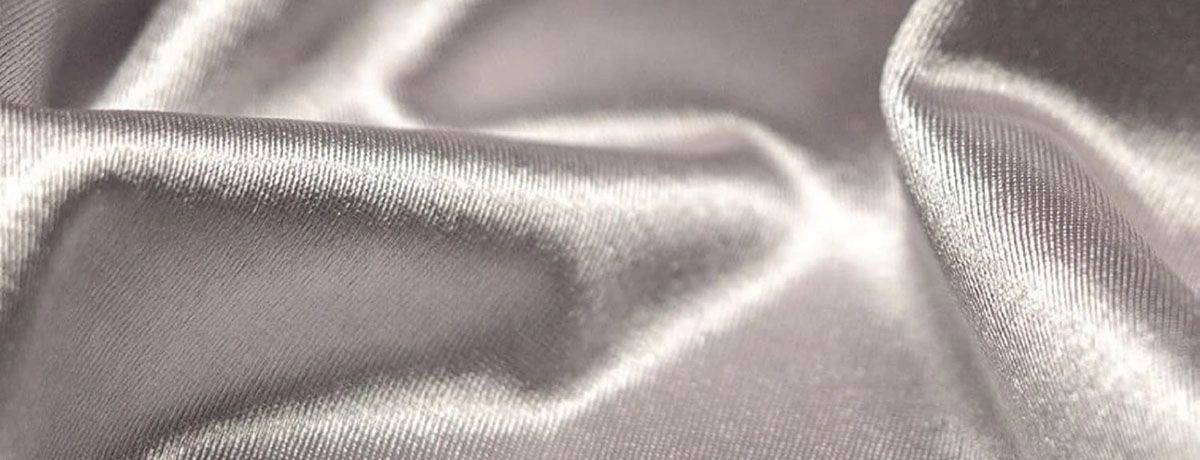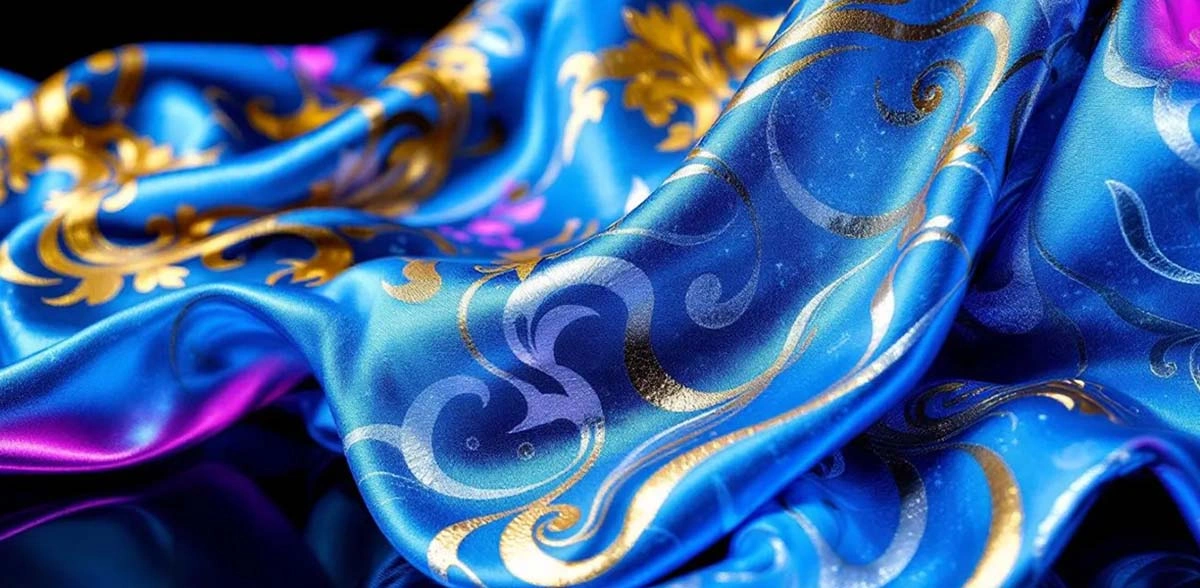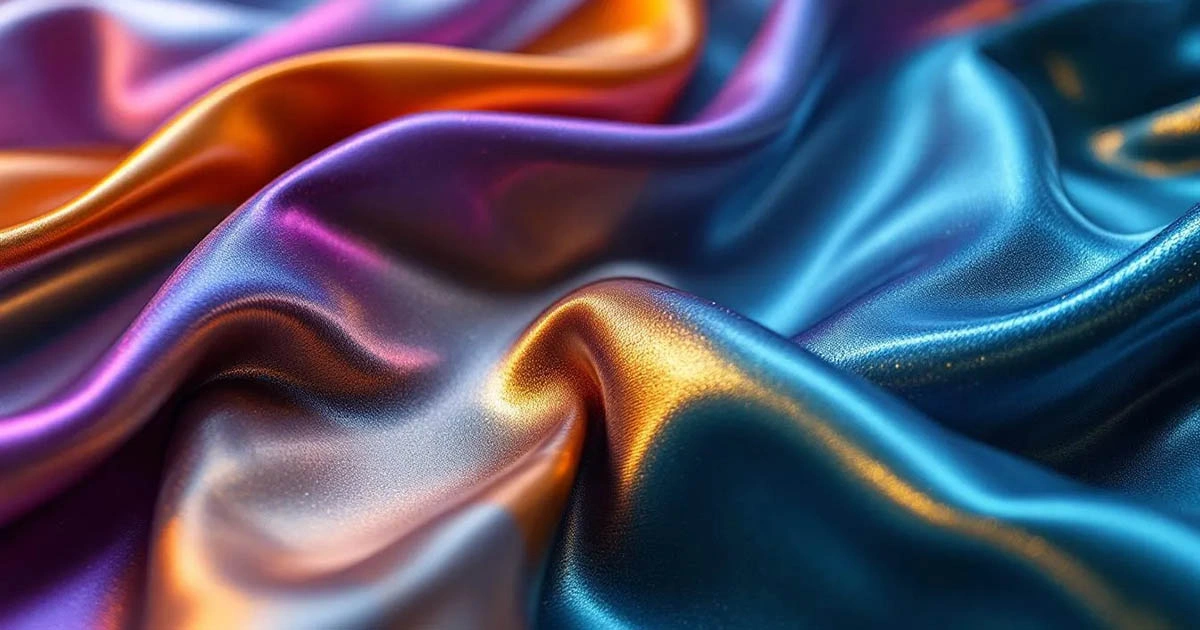Top Shiny Material Fabric Ideas for Sewing Projects

Need shiny material fabric for your next sewing project? From satin to brocade, discover the top shiny fabrics and their best uses. You’ll also get tips on handling these fabrics to make your project sparkle.
Key Takeaways
-
Satin, silk, and organza are versatile shiny fabrics, each offering unique textures and finishes suitable for various sewing projects.
-
Correct handling techniques are essential when working with shiny fabrics to prevent issues such as slippage and damage during sewing.
-
Incorporating shiny fabrics into designs can enhance both fashion and home decor, providing a touch of elegance and creativity.
Exploring Satin Fabric

Satin fabric is renowned for its smooth surface and lustrous finish, making it a popular choice for luxurious garments. This shiny fabric can be made from cotton, rayon, or silk, each variant offering a unique feel and appearance. Charmeuse satin, for example, is silky and lightweight, perfect for high-end apparel such as lingerie. On the other hand, duchesse satin is heavier and ideal for structured gowns.
The versatility of satin fabric extends to its finishes, available in both matte and glossy versions. This influences the final look of the garment, allowing you to choose the perfect sheen for your project. Common uses for satin fabric include lingerie and evening wear, where its luxurious appeal can truly shine.
However, working with satin fabric can be challenging due to its slippery nature. Special handling techniques and tools are required, such as using a walking foot to prevent slipping. Finishing edges with a serger or pinking shears can help prevent fraying. With the right approach, satin fabric can add a touch of elegance to any sewing project.
The Allure of Silk
Silk, with its smooth and soft texture, is the epitome of luxury in the world of fabrics. The natural luster of silk is produced by its raw fiber construction, giving it an elegant shine. This shiny fabric is incredibly versatile, used in everything from elegant evening gowns to comfortable blouses and lingerie. Its lightweight and sheer quality makes it ideal for creating stunning bridal silhouettes that photograph beautifully.
Caring for silk requires some attention. Proper care often involves dry cleaning to maintain its quality, although some silks can be hand washed with mild detergents. Despite its higher price point, the beauty and versatility of silk make it a worthwhile investment for any sewing enthusiast.
Versatility of Organza Fabric
Organza fabric is a lightweight, thin, and sheer material made from silk or synthetic fibers with a plain weave. Its delicate nature can be challenging to work with, but the results are often worth the effort. Available in various colors, from classic bridal shades to vibrant options, organza fabric can be used to create elegant and creative clothing.
When sewing with organza fabric, caution is necessary to avoid damaging its delicate structure. Using fine needles and ensuring proper handling can help achieve beautiful results. Organza’s versatility makes it a valuable addition to any sewing project, adding a touch of elegance and sophistication.
Glitter Fabric for Sparkle

For those who love a bit of sparkle, glitter fabric is a must-have. Made from synthetic fibers like polyester, glitter fabric often incorporates Lurex fibers to enhance its sparkle. This shiny fabric is popular for costumes, accessories, and cocktail dresses, making it a favorite for eye-catching garments.
Working with glitter fabric requires some special techniques:
-
Use superfine pins to prevent tearing.
-
Use pattern weights to help reduce slipping when cutting the fabric.
-
Avoid steam when ironing to prevent damaging the appearance of the fabric.
-
Use zig-zag scissors or French seams to prevent fraying, ensuring your creations remain intact.
The allure of glitter fabric lies in its ability to add a dazzling touch to any project. Whether you’re designing a standout costume or a glamorous evening dress, glitter fabric can provide that extra bit of shine and sparkle.
Brocade: A Touch of Luxury

Brocade fabric brings a touch of luxury to any garment. Originating during China’s Warring States period, brocade became prominent after the development of the silk trade. The introduction of the Jacquard loom in the 19th century revolutionized its production, allowing for more intricate designs at a faster pace.
Known for its thick structure and lower breathability, brocade fabric is commonly used for structured garments like jackets, black dresses, and skirts. It can feature solid colors or complex multi-colored woven designs, enhancing its visual features.
While traditionally made from silk, contemporary brocade can also be crafted from cotton, wool, and synthetic fibers, making it versatile for modern uses.
Faux Leather Options
Faux leather offers a practical and stylish alternative to genuine leather. Key points about faux leather include:
-
Made from polyurethane or polyvinyl chloride
-
Shiny fabric popular for a variety of fashion items, including shoes, handbags, jackets, and upholstery
-
Requires less maintenance compared to genuine leather, making it a convenient choice for many users.
Available in a diverse range of colors, styles, and finishes, faux leather can easily be stitched and molded, enhancing its appeal in fashion design. However, it is unforgiving and requires precise patterns to avoid errors. With the right approach, faux leather can be a versatile addition to your sewing projects.
Patent Leather in Fashion
Patent leather, known for its glossy finish, adds a bold touch to fashion. It can be made from either genuine or synthetic leather, offering flexibility in choice. Commonly used in garments like skirts and jackets, patent leather provides a distinctive, high-shine look.
Despite its flexibility, patent leather generally lacks elasticity due to its rigid plastic coating. To maintain its shine, regular use of a specialized patent leather cleaner is recommended. However, the glossy surface is susceptible to scratches and can become sticky over time.
With proper care, patent leather can make a striking statement in any wardrobe.
Understanding Cire Fabric
Cire fabric, primarily made from polyester, is characterized by its high gloss and moisture resistance. This shiny fabric gained popularity in the 1920s and peaked in the 1930s, especially in evening wear. Today, it remains popular in the cosplay community and outerwear apparel.
When sewing with cire fabric, using the right needle type is essential to avoid damaging the glossy surface. Its unique properties make cire fabric a versatile choice for various creative projects, adding a distinctive shine and durability.
Sateen: Cotton's Shiny Cousin
Sateen fabric, made from cotton, offers a shiny alternative to traditional cotton. Its soft feel and durability make it popular for home textiles and clothing items. To maintain the shine of sateen, it’s recommended to wash it in cool water with mild detergent and avoid high heat drying.
To care for sateen fabric:
-
Iron at a low temperature, preferably on the reverse side, to prevent damage.
-
Avoid harsh chemicals.
-
Opt for gentle cleaning methods to help preserve its luster.
Sateen’s combination of comfort and elegance makes it a favorite among sewing enthusiasts, where people can find inspiration for their satin weave yarns projects.
Polyester Velvet for Winter Wear
Polyester velvet, a synthetic fabric, is renowned for its luxurious feel and rich texture. Its unique weaving process creates a soft, dense pile, contributing to its elegant appearance. Popular in high-end fashion items, polyester velvet is particularly favored for winter apparel due to its warmth-retaining properties.
This shiny fabric’s soft texture and perceived luxury make it a staple in winter clothing. Whether you’re crafting a cozy jacket or a sophisticated evening dress, polyester velvet adds a touch of elegance to cold-weather wear.
Polished Cotton's Subtle Sheen
Polished cotton, known for its elegant appearance, is often used in garments and home decor. Its sheen, achieved through chemical treatment, is more restrained compared to other shiny fabrics, giving it a subtle yet sophisticated look. This fabric holds color well, resulting in vibrant and long-lasting hues.
Additionally, polished cotton is easy to sew, making it a popular choice among crafters. Its combination of beauty and practicality makes it perfect for a variety of projects.
Lame Fabric: Metallic Magic
Lame fabric is known for its metallic colors and medium weight, making it suitable for formal occasions. Its low moisture-wicking, low heat retention, and low breathability require careful handling and sewing techniques.
While many consider the shine of lame fabric overwhelming, it remains a popular choice in fashion and costume design. By adjusting techniques to accommodate its unique properties, you can create stunning and eye-catching garments.
Incorporating Poly-cotton Blends
Poly-cotton blends, typically with a ratio of 50% cotton to 50% polyester, offer a balance of comfort and durability. These blends generally have a low sheen and are not significantly shiny.
Commonly used in casual wear, sportswear, and home textiles, poly-cotton blends are versatile and practical. Their ease of care and comfortable feel make them a staple in many sewing projects.
Choosing the Right Needle for Shiny Fabrics
Choosing the right needle is crucial for sewing shiny fabrics. Universal needles work well for most shiny fabrics, balancing sharpness and rounded points. For decorative stitching, topstitch needles are beneficial due to their sharper point and larger eye.
Stretch needles are ideal for elastic shiny fabrics, helping to prevent skipped stitches. Selecting the appropriate needle size based on the fabric’s weight and thickness ensures smooth stitching and avoids damage. By using the right tools, you can achieve professional results with shiny fabrics.
Handling and Sewing Tips for Shiny Fabrics
Sewing with shiny fabrics can present challenges such as slippage and puckering. Pre-washing polished cotton can help prevent shrinkage after the first wash. When ironing lame fabric, using a low heat setting and a pressing cloth can prevent melting the metallic threads.
For fabrics like polyester velvet, careful handling is necessary to avoid crushing the pile. Storing lame fabric in a dry place prevents tarnishing of the metallic yarn. By following these tips, you can handle shiny fabrics with confidence and achieve beautiful results.
Creative Uses for Shiny Fabrics

Shiny fabrics can elevate everyday looks when used creatively in fashion projects. The reflective quality of velvet adds a unique visual appeal to garments and accessories. In home decor, shiny materials can be used for accent pillows, curtains, or table runners to add a touch of glamour.
Experimenting with different shiny fabrics can inspire creativity and innovation in various sewing projects. Whether you’re crafting a dazzling dress or a chic home accessory, shiny fabrics offer endless possibilities for creative expression.
Summary
Shiny fabrics offer a world of possibilities for sewing enthusiasts. From the luxurious feel of silk to the bold sparkle of glitter fabric, each material brings its unique charm and challenges. By understanding the characteristics and handling tips for these fabrics, you can create stunning garments and accessories that stand out.
We hope this journey through shiny fabrics has inspired you to experiment with these materials in your projects. With the right techniques and a bit of creativity, the possibilities are endless. Embrace the sparkle and shine, and let your sewing projects dazzle.
Frequently Asked Questions
What are some common uses for satin fabric?
Satin fabric is frequently utilized for lingerie, evening wear, and structured gowns, thanks to its smooth texture and luxurious aesthetic. Its versatility makes it a preferred choice for elegant and sophisticated garments.
How should I care for silk garments?
To ensure the longevity of your silk garments, it is advisable to dry clean them, though select silks can be hand washed using mild detergents.
What are the challenges of sewing with glitter fabric?
Sewing with glitter fabric presents challenges such as tearing and slipping. Employing superfine pins, pattern weights, and avoiding steam during ironing can mitigate these issues.
How can I maintain the shine of patent leather?
To maintain the shine of patent leather, regularly use a specialized patent leather cleaner and take care to avoid scratching the surface. This will help keep your items looking pristine.
What needle should I use for sewing shiny fabrics?
When sewing shiny fabrics, it is advisable to use universal needles for general purposes, while topstitch needles are recommended for decorative stitching. For elastic shiny fabrics, stretch needles are the best choice.
Contact MH
MH offer shiny fabric, feel free to reach out to us for more details or inquiries. We're here to help!


